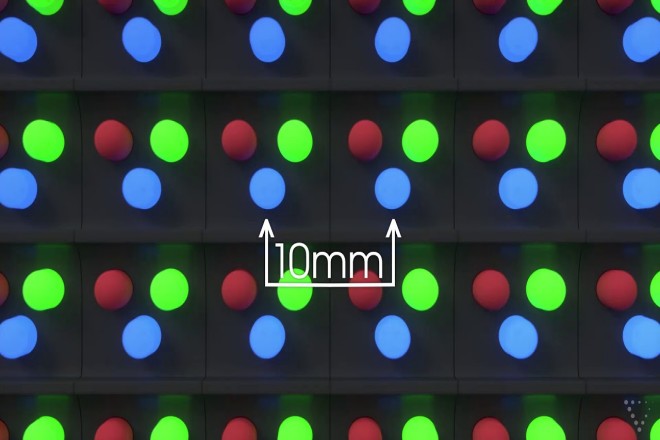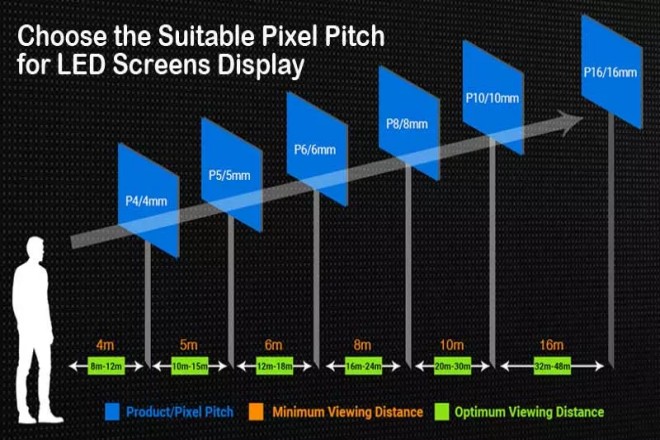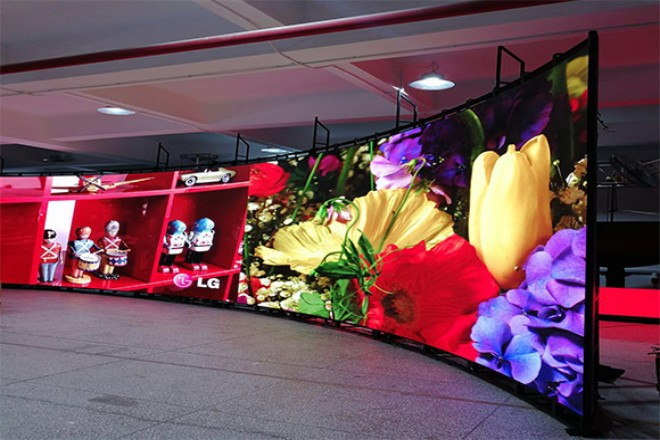Introduction

In the digital age, outdoor LED displays have become an indispensable medium in the urban landscape, commercial publicity, cultural communication, and other fields with their advantages of high brightness, high definition, bright colors, and strong dynamic effects.
With the continuous advancement of technology and the increasing richness of application scenarios, it is particularly important to choose a suitable outdoor LED display.
As a key indicator for measuring the clarity and resolution of the display, the choice of pixel pitch directly affects the display effect, viewing experience, and return on investment.
Therefore, this article aims to explore in depth how to scientifically and reasonably choose the pixel pitch when purchasing an outdoor LED display in order to provide valuable reference and guidance for relevant decision-makers.
1. Understand what is the pixel pitch of the LED display
Imagine that you are standing in front of a huge LED display, which is composed of countless small LED lights, each of which can emit light of different colors.
These LED lights are pixels that are arranged together to form the images and videos we see. The pixel pitch is the physical distance between these LED lights (or pixels), which is expressed in millimeters (mm). For example, P3 means that the distance between two adjacent pixels is 3 mm.
2. Consider the viewing distance of the LED display

When we consider the viewing distance of the LED display, choosing the right pixel pitch becomes very important. Viewing distance and pixel
1). Relationship between pitch
Imagine that you are standing in front of a huge LED display. This screen is made up of many small lights (we call them pixels) that light up together to display images or videos.
2). Close viewing:
If you stand very close, like you are watching a movie in the first row of a movie theater, you will want to see a very clear and delicate picture.
At this time, you need to choose a display with a smaller pixel pitch. Because the pixels are denser, the gaps between them are smaller, and the image looks smoother and more delicate.
3). Long-distance viewing:
However, if you stand far away, such as you are in a square looking at a billboard in the distance, then you don’t need such high clarity.
Because from a distance, the small pixels will be mixed together, and you can’t tell the difference between them. So, at this time, you can choose a display with a slightly larger pixel pitch, which can meet viewing needs and save costs.
4). How to choose pixel pitch?
To help you make a better choice, here is a simple reference method (but please note that this is only a rough estimate):
For outdoor applications, you can try to estimate with a simple formula. The formula is: “Pixel pitch (mm) is approximately equal to viewing distance (meters) divided by 750”.
For example, if the viewing distance is 10 meters, then you can estimate that the pixel pitch is approximately 10 divided by 750, which is 0.013 mm.
But remember that, in fact, the pixel pitch is in whole millimeters, so you need to choose the closest standard value, such as P4 (i.e., 4 mm).
Points to note
Don’t just look at the numbers: Although formulas and estimates are useful, the most important thing is to consider your specific needs. For example, if you are choosing a display for a large event, you may need higher brightness and a larger size, not just a smaller pixel pitch.
Cost considerations: Displays with smaller pixel pitches are usually more expensive. So, consider your budget when choosing and finding the most cost-effective option.
Visual comfort: Finally, don’t forget to consider the visual comfort of the audience. Too small a pixel pitch may cause eye fatigue at close range, while too large a pixel pitch may appear blurry at long distance.
3. Consider the application scenarios of LED display

1). HD demand scenario
Imagine you are watching an HD movie or walking on a busy commercial street and seeing a digital billboard.
- HD video playback:
When you sit in a movie theater or in front of an HD TV at home to watch a movie, you want the picture to be very clear, colorful, and rich in detail.
Similarly, if you see a digital billboard playing HD videos in a shopping mall or exhibition, you also want it to have a cinema-like visual effect.
Therefore, for such scenarios that require displaying HD content, we should choose LED displays with smaller pixel pitches, such as P2.5 or P3.
Such displays can provide higher resolution, making the picture more delicate and the colors more saturated, making the audience feel as if they are in the picture.
- Digital billboards:
Digital billboards are usually located in places with large traffic, such as commercial streets, shopping malls, etc.
In order to attract the attention of pedestrians and convey effective advertising information, the content on the billboard needs to be very clear and eye-catching.
Therefore, for high-definition demand scenarios such as digital billboards, we also need to choose LED displays with smaller pixel pitches.
2). Long-distance viewing scenarios
Now, let’s imagine that you are watching a large billboard outdoors or watching a sports game.
When you are driving on the highway or seeing a huge outdoor billboard on a high-rise building in the city, you are usually watching it from a long distance. Due to the long distance, your vision cannot distinguish very small details, so too high resolution is not required.
On the contrary, in order to reduce costs and adapt to outdoor environments, we can choose LED displays with slightly larger pixel pitches, such as P6 or P8. Such displays can still maintain good visual effects when viewed from a long distance and have a high cost-effectiveness.
In stadiums, spectators usually sit far away from the display to watch games or performances. Therefore, for long-distance viewing scenarios such as stadiums, we can also choose LED displays with slightly larger pixel pitches.
This not only reduces costs but also ensures that the audience can clearly see the content on the display from a long distance.
3). Special demand scenarios
Next, let’s consider some scenarios with special needs, such as traffic signs and long-distance monitoring.
- Traffic signs:
Traffic signs are usually located beside or above the road to indicate the driver’s driving direction and precautions. Since drivers need to obtain information quickly and accurately while driving, traffic signs need to have high clarity and readability.
For such special demand scenarios, we can choose a moderate pixel pitch, such as P4 or P5. Such a display can not only ensure the clarity of traffic signs, but also will not increase costs or maintenance difficulties due to too dense pixels.
- Long-distance monitoring:
In long-distance monitoring scenarios, we need to capture distant targets and show their details. In order to ensure the clarity and detail performance of the monitoring screen, we can choose a moderate pixel pitch. This can not only meet the monitoring needs, but also ensure the quality and stability of the monitoring screen.
4. Consider the cost factors of LED display screens

1). Manufacturing cost: The relationship between pixel pitch and money
Imagine that if you want a super-delicate canvas to paint, then the grid on this canvas (like the pixels on the LED display screen) must be very small, right? However, making such a small grid canvas is much more difficult and expensive than making a large grid canvas.
Because you need more materials and more delicate craftsmanship, and you may need more advanced tools.
Similarly, for LED displays, the smaller the pixel pitch, the more LED beads on the screen, and each bead must be precisely placed and connected, which naturally requires more time and money. Therefore, LED displays with small pixel pitches will cost more to manufacture.
2). Long-term investment: Look far ahead
Now, let’s say you buy a super-detailed painting to decorate your home or office. Although the painting costs a lot of money at the beginning, every time someone sees it, they will be attracted by its beauty and praise your taste. In this way, your home or office becomes more attractive and may bring you more opportunities or friends.
The same is true for LED displays. Although the initial investment of a display with a small pixel pitch may be higher, it can provide a clearer and more detailed picture.
This means that your advertisements, videos, or information can be better conveyed to the audience, attracting their attention and improving your brand image or business results. In the long run, such an investment is likely to bring more benefits and returns.
3). Cost-effectiveness: Find a balance point
So, how do we choose? Do we have to buy the most expensive display with the smallest pixel pitch? Not necessarily. Just like buying clothes, we don’t need to always pursue the most expensive one but find the one that suits us best and has the best cost-effectiveness.
For LED displays, we need to find a balance point based on our needs and budget. If your application scenario does not require high resolution, or your budget is limited, it may be more appropriate to choose a slightly larger pixel pitch. This can meet the needs and save costs.
Conclusion
In summary, choosing the right pixel pitch for outdoor LED displays is a comprehensive consideration process, which requires full consideration of viewing distance, application scenarios, cost factors, and other technical indicators of the display.
Scientifically and rationally selecting pixel pitch can not only ensure that the clarity and resolution of the display meet actual needs but also effectively control investment costs while ensuring the viewing experience and achieving the best cost-effectiveness.
I hope that the discussion in this article can provide you with some useful inspiration and help so that outdoor LED displays can play their unique value and charm in more fields.
Finally, if you want to know more about LED displays, please get in touch with us.
